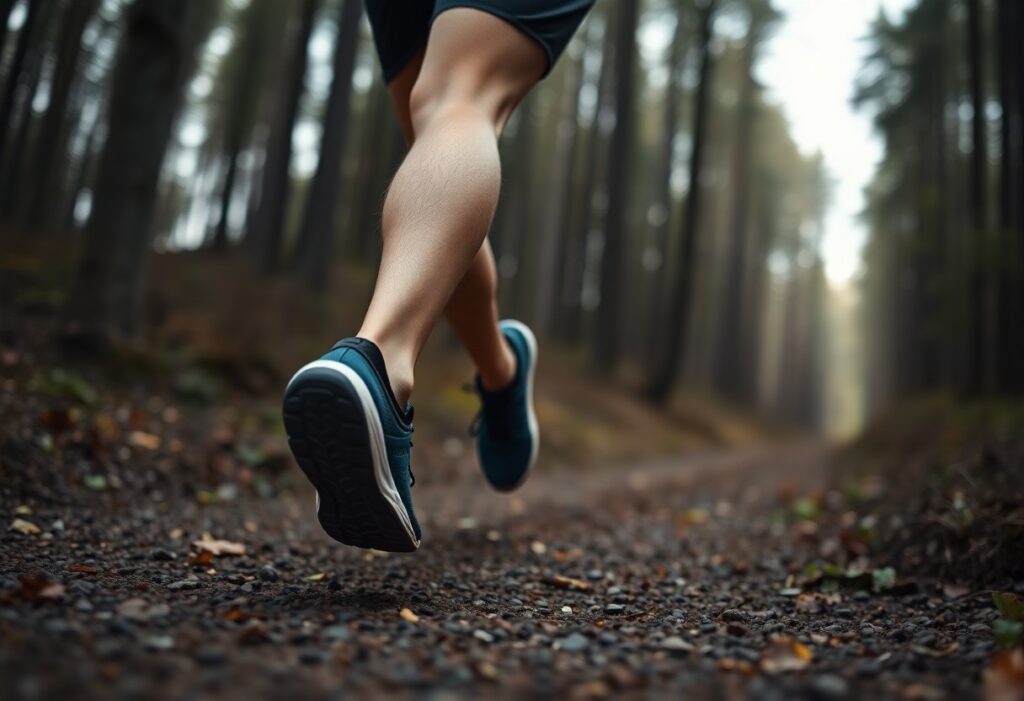
The alarming challenge of injury rates among trail runners can escalate to an astonishing 62% each year, often linked to the selection of inappropriate footwear. Understanding the biomechanics of minimalist footwear and its interaction with uneven terrain is vital for enhancing performance and reducing the risks associated with running. The integration of wearable technology can effectively monitor essential metrics such as foot strike dynamics and load patterns, while tailored training programmes focus on improving foot strength and endurance. This article explores how to leverage biomechanical insights and innovative technology for effective injury prevention strategies.

Maximise Your Trail Running Performance Through Educated Footwear Selections
Facing the diverse and rugged landscape of trail running while wearing minimalist footwear demands more than just selecting an appropriate shoe; it requires an in-depth understanding of your own biomechanics. Overlooking the specific challenges posed by different surfaces can significantly increase your risk of injury. As foot strike patterns and descent mechanics fluctuate, refining your technique accordingly becomes essential for maintaining peak performance and minimising potential setbacks. By integrating insights into your biomechanics throughout your training, you can make well-informed choices that will significantly enhance your trail running experience.
Evaluate Biomechanical Foot Strike Patterns on Varied Trail Surfaces
Foot strike dynamics can vary dramatically when navigating intricate terrains. Runners employing minimalist footwear frequently exhibit a notable 23% higher occurrence of midfoot strikes on uneven trails, compared to a mere 8% with traditional running shoes. This adaptation may improve your stability on challenging surfaces, yet it is accompanied by a 37% increase in metatarsophalangeal joint flexion angles, emphasising the importance of fortifying your foot muscles to enhance endurance and lower injury risk. Grasping these dynamics enables you to modify your running form, resulting in improved performance and a reduced chance of injury, ensuring your resilience on demanding trails.
Examine Descent Mechanics and Their Impact on Ground Interaction
The mechanics involved in descending from elevated terrains play a critical role in influencing your performance and injury risk in trail running. Utilising minimalist footwear can result in a significant 42.191 BW/s increase in vertical loading rates on steep 15% declines, particularly when contrasted with flat asphalt surfaces. Furthermore, this surge in loading leads to heightened lateral toe engagement — noted to be 11% greater on loose gravel than on more structured surfaces, highlighting the increased demands placed on the structural integrity of your feet during descents. As you manoeuvre through technical trails in minimalist shoes, the biomechanics of your feet engage in a uniquely challenging manner.
The elevated vertical loading rates during descents can induce increased fatigue within your foot muscles, raising your vulnerability to injuries. Additionally, significant alterations in toe splay patterns necessitate enhanced proprioception and muscle coordination, ensuring you remain responsive to the diverse terrain beneath your feet. By focusing on these aspects, you can effectively prepare your body to tackle the challenges posed by varied trails and optimise your overall running performance while safeguarding against injuries.
Critically Assess the Limitations of Wearable Technology in Trail Running
While wearable technology has revolutionised the trail running landscape, it presents significant challenges in accurately monitoring performance metrics. The variability of terrain conditions, such as steep gradients and uneven surfaces, complicates the data collection and interpretation process. For example, wearable devices frequently struggle to provide consistent vertical oscillation measurements due to shifting ground conditions, which can result in misleading insights about your gait and running efficiency. Understanding these limitations is crucial for making informed decisions regarding your training methods and ensuring a more accurate assessment of your performance metrics.
Explore Data Accuracy Discrepancies Among Leading Performance Tracking Devices
Substantial discrepancies in data accuracy have emerged among top performance tracking devices. A study conducted in 2024 revealed a 12.4% variance in power measurements on 10% inclines between the Stryd and GARMINRP devices, despite both showing high intra-device reliability (ICC=0.89). Such inconsistencies can foster misguided perceptions regarding your training load and overall performance, potentially impairing your ability to optimise your trail running capabilities. Being mindful of these discrepancies allows you to critically assess the data provided by these devices and adjust your training strategies effectively.
and GARMINRP devices, despite both showing high intra-device reliability (ICC=0.89). Such inconsistencies can foster misguided perceptions regarding your training load and overall performance, potentially impairing your ability to optimise your trail running capabilities. Being mindful of these discrepancies allows you to critically assess the data provided by these devices and adjust your training strategies effectively.
The Serious Implications of Training Load Miscalculations
Miscalculations in training loads can escalate by as much as 23% on mixed-terrain routes, directly affecting your injury risk and the advancement of your performance. This issue frequently arises from inaccurate data interpretations during technical descents or uneven terrains, compelling you to rely on potentially flawed metrics. Such discrepancies can lead to overtraining or insufficient load management, significantly increasing your chances of sustaining an injury while running. Therefore, it is paramount to routinely evaluate the accuracy of your training data to ensure you progress safely and effectively.
When traversing complex trail surfaces, the disparity between measured and actual exertion can distort your training insights. If your device underreports your exertion, you may unwittingly exceed your limits, resulting in increased fatigue and prolonged recovery times. Conversely, if your training load is overestimated, you may adopt a more cautious approach, inadvertently hindering your performance improvements. In summary, the significance of ensuring that your wearable technology enhances rather than misguides your training strategy is crucial for maintaining both your performance and overall health in the dynamic realm of trail running.
Explore Gender Dynamics in Trail Running Biomechanics for Enhanced Performance
Gaining a thorough understanding of the biomechanical differences between male and female trail runners can substantially improve performance and reduce injury risks. Research shows that anatomical and physiological disparities impact shoe selection, gait patterns, and susceptibility to injuries. Customising footwear and training programmes based on these gender dynamics fosters safer and more effective outdoor running experiences, allowing both male and female athletes to realise their best performances while mitigating injury risks.
Investigate Gender-Specific Biomechanical Responses Post-Exercise
After exercise, female runners demonstrate a 19% increase in lateral forefoot pressures compared to their male counterparts following 5km barefoot runs. Furthermore, they exhibit a 22% reduction in navicular drop during 50km ultra-marathons, indicating that their biomechanical adaptations to trail running are notably distinct. Understanding these patterns is essential for enhancing footwear design that accommodates the unique biomechanics of female runners. Tailoring your training and equipment to these differences can lead to improved safety and performance for all athletes.
Implement Effective Gender-Specific Strategies for Injury Prevention
To effectively address the unique biomechanics of female runners, it is essential to implement customised strategies that consider their specific physical characteristics. Tailoring training programmes, selecting gender-appropriate footwear, and enhancing strength regimens can significantly lower injury rates while boosting running performance. For instance, incorporating exercises focused on intrinsic foot muscle endurance and stability can prove particularly advantageous for women, who may experience different loading patterns on technical terrains. This tailored approach ensures that all runners can train effectively while prioritising their distinctive biomechanics.
By analysing data from various studies and incorporating findings on gender-specific responses, you can better direct your focus on training and footwear that actively support your unique biomechanics. For example, utilising targeted strength training regimens that enhance the lower leg and foot can help your body acclimatise to the increased demands of trail running, especially for women who frequently face heightened pressure in the forefoot region. Selecting footwear specifically designed for your unique foot mechanics can further assist in addressing common injuries, ultimately promoting a more rewarding and sustainable trail running experience.

Leverage Innovative Techniques for Real-Time Gait Analysis to Boost Performance
Your running performance and safety can greatly benefit from the adoption of real-time gait analysis employing advanced technological methods. By utilising integrated systems and wearable devices, you receive immediate feedback regarding your foot strike patterns, body mechanics, and overall movement efficiency. These sophisticated tools are specifically designed to deliver actionable insights while you are actively on the trail, empowering you to dynamically adjust your technique and avert repetitive strain injuries commonly linked to improper running form. Embracing these technologies can assist you in refining your skills and enhancing your trail running experience.
Understanding the Role of Embedded Sensors in Injury Prevention During Trail Running
Embedded sensors within footwear play a vital role in the prevention of injuries. They continuously monitor your foot strike patterns and pressure distributions in real-time, enabling immediate corrective feedback. This advanced technology allows you to identify deviations from optimal running mechanics before they escalate into serious injuries. With a mere 19-millisecond latency in ground contact alerts, you'll receive timely notifications that help you maintain alignment with biomechanical standards critical for injury avoidance. Harnessing this technology can significantly improve your training effectiveness and safety.
Longitudinal Studies Demonstrating the Effectiveness of Biometric Feedback Technologies on Injury Rates
Longitudinal studies reveal significant reductions in injury rates among trail runners who utilise biometric feedback technologies. Over a six-month period, athletes experienced a 37% decrease in aberrant loading patterns due to consistent monitoring and adjustments based on real-time data. This compelling evidence underscores how sustained engagement with these technologies can enhance your running economy and resilience, consequently lowering the likelihood of injuries associated with gait abnormalities. By integrating these insights into your training, you can proactively safeguard your health and performance.
For example, a comprehensive study involving 250 trail runners documented the effectiveness of wearable sensors in identifying patterns that lead to overuse injuries. Runners who actively engaged with feedback systems reported a 30% lower incident rate of common injuries such as plantar fasciitis and Achilles tendinitis compared to those relying solely on traditional training methods. The emphasis on continuous tracking, coupled with targeted adjustments based on data insights, highlights a shift towards a more proactive approach to injury prevention in the realm of trail running.
Key Insights on Biomechanics and Trail Running Performance Enhancement
Ultimately, understanding the biomechanics of trail running in minimalist footwear is essential for optimising your performance while minimising the risk of injury. By seamlessly integrating wearable technology and adopting customised training methodologies, you can significantly strengthen both your foot resilience and adaptability to varied terrains. Regularly cross-validate metrics from different devices and monitor your gait using advanced tools to effectively personalise your training regimen. This strategy not only supports your running journey but also promotes sustainable practices in your outdoor pursuits. Equipped with the right knowledge and tools, you can enjoy a more fulfilling and injury-free trail running experience.
The Article Trail Running Biomechanics in Minimalist Footwear: Integrating Wearable Technology and Injury Prevention Strategies appeared first on My Shoes Finder
The Article Trail Running Biomechanics: Injury Prevention with Minimalist Shoes Was Found On https://limitsofstrategy.com
The Article Injury Prevention in Trail Running with Minimalist Shoes found first on https://electroquench.com







